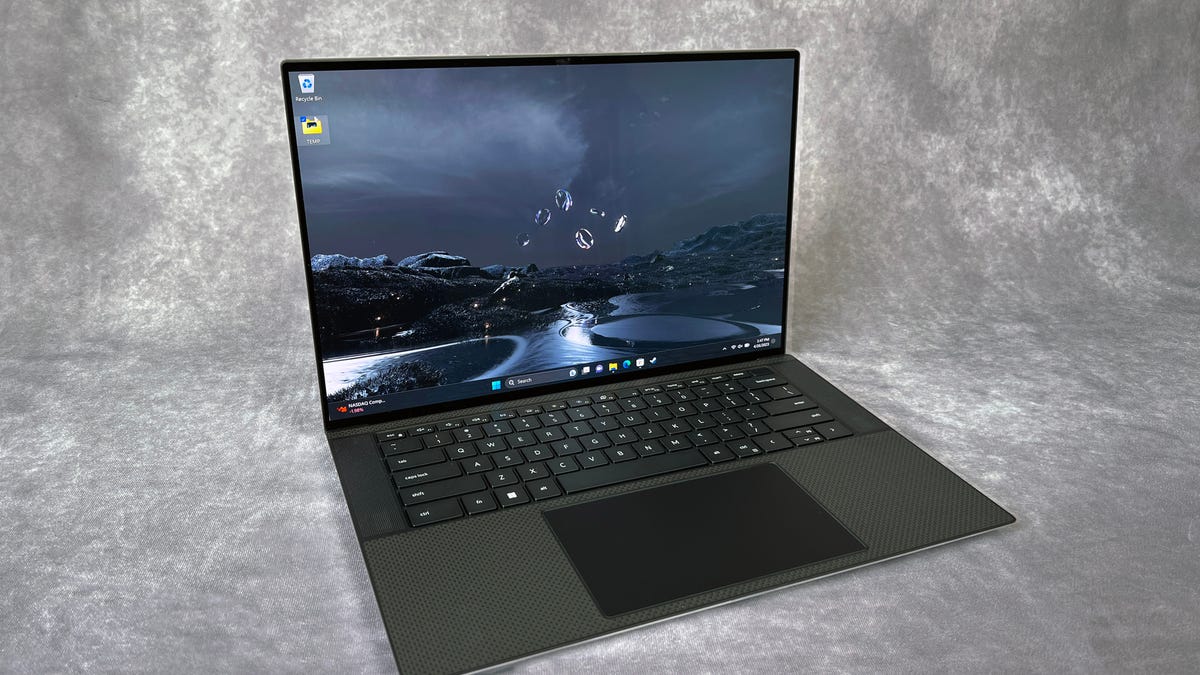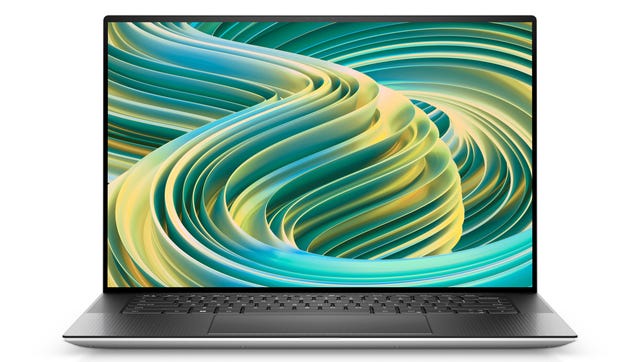

8.1
Dell XPS 15 9530
Like
High-end GPU options
Bright, colorful OLED touchscreen
Excellent build quality
Don’t like
Low-res webcam
Could use a few more ports
No design changes or improvements
One of my favorite laptop tricks is finding a system that can play games, and play them well, without looking and feeling like a gaming machine. Among the top performers in this stealthy category is the Dell XPS 15, which looks and feels like a MacBook Pro alternative but also is capable of performance as good as that of many gaming laptops.
But those gaming chops are just a bonus. The real appeal here is that this is a slim, sleek system for creative pros looking to do photo and video editing or design work. Razer’s Blade laptops cover some of the same ground, but without the crossover office-ready look and feel of the XPS 15.
Clad in a light silver-gray, with a textured wrist rest and big touchpad, the XPS 15 would look just as home in a coffee shop as in a boardroom. A MacBook Pro, in either its 14-inch or 16-inch version, also combines an excellent display with lots of both CPU and GPU power, but Apple systems are notoriously gamer-unfriendly if that’s important to you.
The model reviewed here is a high-end one, with an Intel Core i7-13700H, 32GB of RAM, 1TB SSD, and an Nvidia RTX 4070 GPU. That configuration is $2,799, and trading up to an even faster Intel Core i9 brings it up to $2,949. The XPS 15 currently starts at $1,499 with a Core i7 CPU, Intel Arc graphics, 512GB SSD and a regular non-touch 1,920×1,200 LCD.
Design and display
One thing the XPS 15 offers that many of its competitors do not is a touchscreen OLED display. These screens have become more common in laptops over the past few years but are still not the norm. On the plus side, an OLED display offers excellent brightness and contrast and can look fantastic for gaming and video viewing. On the other hand, the 3,456×2,160 OLED option in the XPS 15 is locked to a 60Hz refresh rate, while gamers are increasingly demanding higher refresh rates.
Still, the display looks great, and in keeping with the rest of the modern XPS line, it has a very thin border around the screen — Dell calls this its Infinity Edge, which just means really thin bezel. But having that very thin top border around the screen might be why this system is still stuck with a 720-resolution webcam, which is frankly unacceptable in an otherwise top-shelf laptop like this.
The body is, like many premium laptops, cut from solid aluminum blocks for durability, and the screen has a Gorilla Glass coating as well. On top of the aluminum chassis is a carbon fiber top layer, which has the distinctive XPS pattern along the wrist rest. It’s the same as last year’s XPS 15, so this 2023 version basically just updates the available components inside. However, the keyboard remains a key feature, with large keycaps and good tactile feedback, without being overly clacky.
Practical ports
While slim laptops are dropping ports at a rapid rate, the XPS 15 is sitting in the middle ground. It has three USB-C ports, plus a headphone jack and a full-size SD card slot. That means it’s missing USB-A, HDMI or anything else, although Dell packs a tiny USB-C hub in the box.
Power is via USB-C, so nearly any similar charger will work, which is a rarity for a system with a powerful GPU, but if you use an underpowered charging brick, the system will alert you. It’ll still work, but the charging may not be able to keep up with intense GPU use, for example.
Creativity and gaming
I used the XPS 15 for some photo and video editing, using Photoshop and Premiere, and found it worked flawlessly, although based on these high-end specs, I expected nothing less. The bright screen helped with my photo editing, although the good-but-not-great touchpad made me miss MacBook Photoshop navigation.
With an Nvidia 4070, this is by default a high-end gaming laptop as well (and costs about the same as a comparable high-end 4070 crossover gaming system like the Razer Blade). In addition to our regular benchmark tests, I ran several current games on it, from Hogwarts Legacy to Marvel’s Midnight Suns to Star Wars: Jedi Survivor. All ran smoothly, even the poorly optimized Jedi Survivor. It helps that the screen’s 60Hz refresh rate keeps you from worrying about higher frame rates, but I found it was helpful to play at a lower resolution, like 2,560×1,200, instead of the full near-4K resolution.
The only catch is that this is a lower-power 40-watt version of the 4070 GPU, while the larger XPS 17 has access to the more powerful 60-watt version. For FHD gaming, however, it should make a big difference. Also keep in mind that if you’re primarily using this for creative work, you’ll want to download the latest Studio drivers from Nvidia (which come pre-installed), rather than the usual gaming drivers.
I love being able to play games at serious detail settings on a conservative-looking laptop, and to be able to get away with just a simple USB-C charger. It’s about 4.25 pounds, so it’s not a laptop you’ll want to carry around every day in a shoulder bag. For a bigger screen at a light weight, look at something like LG’s excellent Gram line. With its big, high-res OLED screen and powerful components, I see the XPS 15 as a good Windows-based alternative to a MacBook Pro, or as a semi-desktop-replacement system for your home office.
Geekbench 5 (multicore)
Apple MacBook Pro (16-inch, 2023) 15009Samsung Galaxy Book 3 Ultra 12558Dell G16 7620 12520Asus Zenbook Pro 16X OLED (UX7602) 12476Dell XPS 15 9530 12375Dell Inspirion 16 Plus 7620 11875
Cinebench R23 (multicore)
Dell G16 7620 17942Samsung Galaxy Book 3 Ultra 15965Dell XPS 15 9530 15776Dell Inspirion 16 Plus 7620 15045Asus Zenbook Pro 16X OLED (UX7602) 14958Apple MacBook Pro (16-inch, 2023) 14803
3DMark Wild Life Extreme
Dell G16 7620 18004Dell XPS 15 9530 14554Apple MacBook Pro (16-inch, 2023) 12989Asus Zenbook Pro 16X OLED (UX7602) 12892Samsung Galaxy Book 3 Ultra 12853Dell Inspirion 16 Plus 7620 10965
Guardians of the Galaxy (High @ 1920 x 1080)
Dell XPS 15 9530 136Samsung Galaxy Book 3 Ultra 131Asus Zenbook Pro 16X OLED (UX7602) 124Dell G16 7620 123Dell Inspirion 16 Plus 7620 111
Online streaming battery drain test
Apple MacBook Pro (16-inch, 2023) 1474Dell Inspirion 16 Plus 7620 677Samsung Galaxy Book 3 Ultra 634Dell XPS 15 9530 604Asus Zenbook Pro 16X OLED (UX7602) 338Dell G16 7620 287
System Configurations
| Dell XPS 15 9530 | Microsoft Windows 11 Home; 2.4GHz Intel Core i7-13700H; 32GB DDR5 4,800MHz RAM; 4GB Nvidia GeForce RTX 4070 GPU; 512GB SSD |
|---|---|
| Samsung Galaxy Book 3 Ultra | Microsoft Windows 11 Home; 2.4GHz Intel Core i7-13700H 16GB DDR5 6,000MHz RAM; 6GB Nvidia GeForce RTX 4050 GPU; 1TB SSD |
| Apple MacBook Pro (16-inch, 2023) | Apple MacOS Ventura 13.2; Apple M2 Pro (12 CPU cores, 19 GPU cores); 32GB LPDDR5 RAM; 1TB SSD |
| Dell Inspirion 16 Plus 7620 | Microsoft Windows 11 Home; 2.3GHz Intel Core i7-12700H; 16GB DDR5 4,800MHz RAM; 4GB Nvidia GeForce RTX 3050 Ti GPU; 512GB SSD |
| Asus Zenbook Pro 16X OLED (UX7602) | Microsoft Windows 11 Home; 2.3GHz Intel Core i7-12700H; 16GB DDR5 6,400MHz RAM; 6GB Nvidia GeForce RTX 3060 GPU; 1TB SSD |
| Dell G16 7620 | Microsoft Windows 11 Home; 2.3GHz Intel Core i7-12700H; 16GB DDR5 6,400MHz RAM; 6GB Nvidia GeForce RTX 3060 GPU; 512GB SSD |
The best laptops in every category
